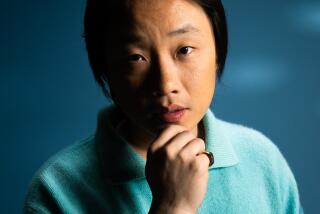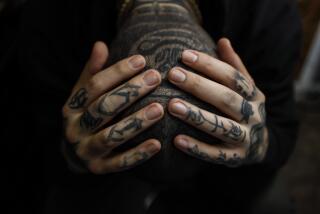A cartoon for China’s new generation
- Share via
BEIJING — Little P is a red-haired joker with a robot dog and a mind bursting with rebellion. She has a closet filled with tight, midriff-baring clothes. Her biggest worry is getting fat.
Meet Bad Girl, a cartoon aimed at a generation of young Chinese raised on a diet of imported video games, Kentucky Fried Chicken and communist rhetoric.
When Song Yang published his Bad Girl comic book last year, his friends asked whether the character was him in disguise. “I guess I am a lot like her,” said the elfin 25-year-old, dressed in a pair of tight black jeans and a T-shirt. Asked what that meant, he tilted his head and smiled. “I’m naughty.”
Song, a bad boy with a pen and paper, has the oversized ambition of creating a cartoon character that can help redefine the world’s image of modern China and boost a domestic industry overshadowed by manga from Japan and manhwa from South Korea. China, with its 1.3 billion people, boasts one of the world’s biggest cartoon markets, but the vast majority are imports.
But Song is trying to catch a popular culture wave in a country where the tide shifts quickly, the competition for the youth market is fierce and the generation gap is measured in years rather than decades.
“Chinese kids, especially in the cities, have a cocky, smart, urban edge to them,” said Stacey Duff, the arts editor for Time Out Beijing, an English-language magazine to which Song is a regular contributor. “If they see something that doesn’t match their lives, they’re going to lose interest fast.”
Children of change
At first glance, Beijing’s twentysomethings could be easily transplanted to an American college campus or skate park. Walk the streets in northwest Beijing, the city’s university district, and you will see young women window-shopping in tight jeans and knee-high boots and guys with spiky, dyed hair bopping to their iPods.
Their parents lived through Mao Tse-tung’s 1966-76 Cultural Revolution, when China’s brightest youths were banished to the countryside to be reeducated. But this generation was born after Chinese leaders opened the country, spurring a flood of imported goods and ideas and double-digit economic growth. They are mostly single children, thanks to the government’s one-child policy, and they enjoy the attention and resources of two extended families.
Newsstands are filled with glossy magazines promoting the hottest Taiwanese pop stars and latest weight reduction miracle. That this giant nation could veer from Mao’s disastrous Great Leap Forward collectivization campaign, when millions died of starvation, to a nation of calorie-obsessed youths in just a few decades is testament to China’s dramatic economic transformation.
On weekends, the upscale shopping malls are crowded with young couples who plunk down $3 for a Starbucks latte and $9 for a ticket to see “Casino Royale,” the first James Bond movie to be approved by the government for the big screen. (Pirated versions of all the Bond movies can be bought on the streets for a couple of dollars.)
But China’s youths also face stressful competition for good schools, jobs and even relationships, because the one-child policy and the cultural affinity for boys has led to a worrisome gender imbalance. And the contradictions between the government’s communist ideals and the get-rich-quick economy have exacerbated the cynicism that permeates youth culture in most countries.
Little P isn’t exactly a paragon of modern Chinese virtue. She talks back to her parents, makes fun of ancestor worship and secretly smokes cigarettes. Her dysfunctional family is more like the Simpsons than the Cleavers.
But look more closely, Song said, and Bad Girl offers a positive message.
“A lot of [Chinese] young people, they appear to be very bad on the surface,” he said. “They might appear to be lazy, they may cheat people often, they’re crazy about money. But when they come across serious things, the kindness in their heart will be expressed.”
Song finds his inspirations nearby, in places such as Hou Hai Lake, where he hangs out with his friends in the old stone buildings that have been refashioned into trendy cafes and nightclubs.
“I don’t have a very rich life because of my young age,” he said. “I’m not in a position to advocate love and peace and such big ideas. What I can do is try to understand the life around me.”
Song is riding high: Bad Girl is featured in an advertisement for Hugo Boss’ Man fragrance; he has a gallery show in Beijing’s trendy Dashanzi art district; and he is working on a “cartoon-based record” for a foreign music company, featuring original songs sung by him and a voice created for Bad Girl’s character. The record is due out this year.
Artists’ new freedoms
In the last decade, China’s leaders have significantly relaxed their controls on artists, leading to a flowering of painting, photography and performance art exploring previously taboo subjects. The first generation of contemporary Chinese artists to gain the attention of the West produced work with a political edge, often focused on the Cultural Revolution. Some of those pieces are being snapped up for millions of dollars.
Younger artists are less likely to look to China’s political past for inspiration, said Luo Xiaohu, owner of the Courtyard Gallery, where Song’s work is on display. Luo pointed to a piece called “The Crying Cinema,” in which Little P sits next to her mother in a darkened movie theater. The audience includes some familiar faces, including Mickey Mouse; Lu Xun, a famous Chinese writer; Astroboy, a popular Japanese manga character; and Marxist revolutionary Che Guevara.
“He’s regarded by many Chinese young people as a cool figure,” Luo said of Che. “But they don’t know what the revolution was.”
Artists are still wary of crossing the Chinese government, which occasionally steps in with restrictions reminiscent of the early days of communism, when art was a propaganda tool.
In January, Beijing’s Cultural Bureau announced it was drafting legislation to ensure that artwork would “be healthy, abide by the constitution and not offend ordinary citizens,” according to official media reports. A bureau official said the new regulation would cover painting, photography and performance art and might be extended to other areas, such as multimedia art.
China’s leaders are using their market power to promote the domestic animation industry. Two years ago, the government opened animation centers at a dozen film studios and colleges and offered tax breaks and other assistance to finance production. The government recently banned the broadcast of imported cartoons during prime time.
Still, many Chinese cartoonists have moved into commercial art because they were frustrated by the government controls. It is painful to face restrictions on his dark-themed creativity, Song said, though he tries to steer clear of the censors by avoiding the obvious hot buttons: pornography, violence or overt criticism of the government.
Subverting authority is a skill Song apparently perfected at an early age. He recalled how his father, a trader, and his mother, an engineer, had discovered and burned the sketchbooks into which the youngster had copied popular manga characters. He said they wanted him to pursue a more marketable talent, such as oil painting.
Song agreed, attending art school twice a week and painting landscapes and portraits that elicited praise from his teachers. But he also kept drawing cartoons, producing his first serial, “The Magic Box,” before he finished high school. By the time he graduated from Tianjin Polytechnic University in 2004, he was selling cartoons to magazines and organizing exhibitions.
Mass audiences
Song looked for ways to get his work in front of a mass audience. He published cartoon versions of two famous Chinese novels, “Wild Animals,” by Wang Shuo and “Jade Buddha,” by Hai Yan. He designed the poster for Zhang Yimou’s movie “Hero” and published a comic book serial for cellphones. Song also worked as a fashion model, TV host and DJ.
“I don’t accept the ways of Chinese cartoonists -- most of them spend 10 or 20 years just drawing and drawing,” he said. “That’s not what I want to do. I write novels, I sing music.”
Song is an unapologetic self-promoter who argues that Chinese cartoonists must figure out how to deliver their products to young people via their cellphones, computers, iPods or television sets. He has opened a Bad Girl theme store in Beijing, where he plans to sell books, figurines and other products.
Right now, he said, he is working from dawn to dusk on his record, which he describes as a still-in-progress mix of musical genres, from Peking opera to Taiwanese pop to jazz. He was scheduled to perform one of his songs this month on CCTV, the state-owned television network.
Asked what he hopes to be doing in a decade, Song quite happily proclaims ignorance.
“If I clearly knew what was going to be my life career at this age,” he said, “it would be a horrible thing.”
Yin Lijin of The Times’ Beijing Bureau contributed to this report.
More to Read
The biggest entertainment stories
Get our big stories about Hollywood, film, television, music, arts, culture and more right in your inbox as soon as they publish.
You may occasionally receive promotional content from the Los Angeles Times.










